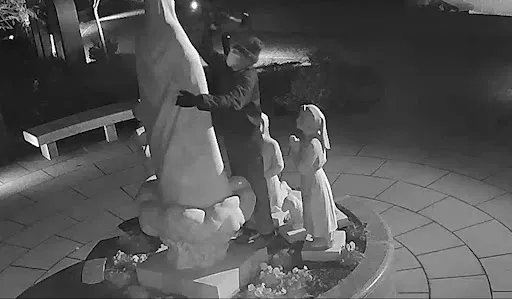
Washington, D.C. Newsroom, Jan 14, 2022 / 15:30 pm (CNA).
A marble statute of Our Lady of Fatima outside the Basilica of the National Shrine of the Immaculate Conception in Washington, D.C., suffered “irreparable damage” at the hands of a still unidentified assailant and will be replaced, a basilica spokesperson has told CNA.
Police now know the identity of a “suspect” sought in connection with the Dec. 5 attack, the spokesperson said, referring further questions about the investigation to the Metropolitan Police Department.
A spokesperson for the Metropolitan Police Department confirmed that a “person of interest” has been identified but said police are not releasing any further information at this time. No arrests have been reported.
In another development, Cardinal Timothy M. Dolan of New York, chairman of the U.S. Conference of Catholic Bishops’ Committee for Religious Liberty, has announced that a public rosary in “response to the recent vandalism of a statue of Our Lady of Fatima” will take place at the basilica on Sunday, Jan. 16 in observance of Religious Freedom Day.
“I encourage all Catholics to participate in this event, as we pray that all religious communities would be free to worship without fear and to continue to bless this great country,” Dolan tweeted Friday.
The rosary will be held at 1:30 p.m. EST, and will be live streamed.
“Religious art instructs and inspires. It reminds us that we live most fully when we direct our lives toward our Creator and our neighbors,” Dolan said. “On the other hand, the defacement of such public symbols of the sacred degrades our life together and harms the common good.”
Police have shared surveillance footage that shows a man wearing a mask approaching the Marian statue located outside the basilica. The man steps up to the statue, withdraws a mallet or hammer-like tool, and appears to strike at the statue’s hands. He climbs back down only to step up again and repeatedly whack at the statute’s face, sending pieces of marble flying.
The basilica spokesperson told CNA the cost of the Carrara marble statue’s replacement is “to be determined.” No decision has been made yet about when or how the existing statue will be removed and disposed of, the spokesperson said.
The statue is valued at $250,000, according to a police report obtained by CNA. The case is not being treated as a hate crime, police have said.
If you value the news and views Catholic World Report provides, please consider donating to support our efforts. Your contribution will help us continue to make CWR available to all readers worldwide for free, without a subscription. Thank you for your generosity!
Click here for more information on donating to CWR. Click here to sign up for our newsletter.




The case is NOT being treated as a hate crime??? Why not? Unless the police have information that the perpetrator is mentally ill, in my opinion it SHOULD be treated as a hate crime. Given the value of the defaced statue, a quarter of a million dollars, it should also be treated as a Felony. Having to use scarce funds to replace the statue means less money for charitable projects. A strong signal needs to be sent that “hate crimes” like this are NOT acceptable.
Take off the mask and identify yourself.
Surely you will accept the consequences of your ‘beliefs’ as you can support them in argument?
Right?
Or, you must run away as cowardice always holds hands with a willful, extreme ignorance.
The DC police by contending that it is not a hate crime nor a felony are legitimizing vandalism against the Church the precursor to assaults against the People of God and God whom they hated before they hated us. Then of course the decision justifies the use of the resources elsewhere.